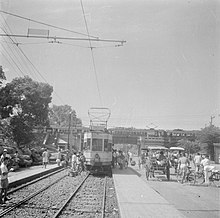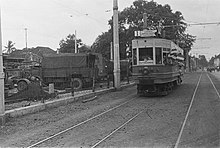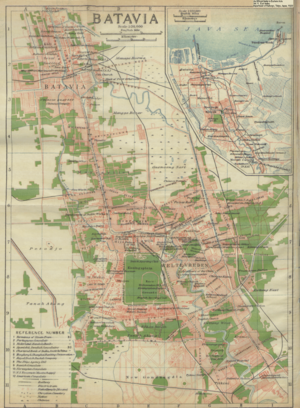Trams in Jakarta
| Trams in Jakarta | |||||||||||||||||
|---|---|---|---|---|---|---|---|---|---|---|---|---|---|---|---|---|---|
 | |||||||||||||||||
| Operation | |||||||||||||||||
| Locale | Batavia, Dutch East Indies Jakarta, Indonesia | ||||||||||||||||
| Status | Closed | ||||||||||||||||
| Infrastructure | |||||||||||||||||
| Track gauge | 1,188 mm (3 ft 10+25⁄32 in) | ||||||||||||||||
| Minimum curve radius | ? | ||||||||||||||||
| |||||||||||||||||
| |||||||||||||||||
| |||||||||||||||||
| |||||||||||||||||
The Jakarta tram system was a transport system in Jakarta, Indonesia. Its first-generation tram network first operated as a horse tram system, and was eventually converted to electric trams in the early twentieth century.
History
[edit]Dutch era
[edit]The first horse tram in Batavia was operated by Bataviasche Tramweg Maatschappij (BTM, Batavia Tramways Company). The horse tram line was inaugurated on 20 April 1869, long before trams existed in the Netherlands- using a gauge width of 1,188 mm (3 ft 10+25⁄32 in), connecting Batavia Old Town with Weltevreden.[1][2] At the time the tram, pulled by 3-4 horses, could accommodate up to 40 passengers. In April 1869 an estimated 1,500 passengers had been served by the system and in September 1869 it was increased to 7,000 passengers.[3]
As a result of horse trams operational problems experienced by the BTM, in 1880 the operation was handled temporarily by Firma Dummler & Co. Two years later, on 19 September 1881 Bataviasche Tramweg Maatschappij officially changed its name into Nederlands-Indische Tramweg Maatschappij (NITM, Netherlands Indies Tramways Company) and took over Batavia trams operation previously handled by Firma Dummler & Co.[4] Under NITM, there was a gradual overhaul of its fleet and infrastructure, which the replacement of horse with steam locomotives produced by Hohenzollern Locomotive Works. The first locomotive was purchased for ƒ8,800 and the fleet replacement process was completed in 1884. The horse tram service was closed from 12 June 1882. NITM services reopened on 1 July 1883 with the inauguration of the steam tram service as well as the new Batavia Old Town–Harmonie line.[3]
Four years after the operation of the Batavia Old Town–Harmoni steam tram line, electric trams was introduced under the operation of the Batavia Elektrische Tram Maatschappij (BETM, Batavia Electric Tram Company), making it a competitor to the NITM's steam tram. BETM began operation since the inauguration of Batavia Old Town–Ragunan Zoo line on 10 April 1899 which was extended to Tanah Abang Station in November 1899, but unfortunately the extension was closed in 1904. In 1900 BETM extended its tram network, reaching Jembatan Merah, Tanah Tinggi, and Gunung Sahari areas by crossing Ciliwung River. With the increasing number of years, BETM continued to expand its tram network until 1920, it marked with unhealthy competition between BETM and NITM. The competition caused ticket prices became too expensive that Batavia city government demanded NITM to upgrade its fleet to become electric-powered, but was refused by NITM itself.[3]
As a result of the competition, the two began to impose transit tickets and special schedules during rush hour. On 31 July 1930 NITM and BTM were merged to form Bataviasche Verkeers Maatschappij (BVM, Batavia Transport Company). The merger combines 1 steam tram line, 2 trolleybus lines, and 7 bus routes operated by both NITM and BETM.[3]
Under BVM, the tramways underwent significant changes. In former NITM routes, the electrification program was carried out from April 1933 to 1934. The electrification made the travel time from Batavia Old City to Jatinegara cut by 10 minutes. BVM experienced its peak in 1934, where it operating 5 electric tram lines with a total length of 41 kilometers.[3]
The decline of the Batavia (Jakarta) tram began in 1935. As a result of Great Depression, BVM had financial problems, which its popularity was threatened by the emergence of other modes such as bemo and oplet. As a result of this financial constraint, the BVM bus service was closed and the company will only focus on the trolleybus service. The BVM bus service only reopened in 1941.[3]
Post-Dutch era
[edit]In March 1942, the Dutch East Indies entered the Japanese occupation. The trams service managed by the BVM was taken over by the Japanese army and changed its name to the Nippon Batavia Tram Army. Then in June 1942 it was changed to Seibu Rikuyo Batavia Shiden, and then, Jakaruta Shiden (ジャカルタ市電, Jakarta Trams). Under the control of Jakaruta Shiden the Jakarta tram underwent overhaul, including abolishing the class system, dismissing BVM workers who were Dutch citizens, applying Japanese symbols on tram bodies, and doubling tracks on Gunung Sahari–Pal Putih line.[3]

After Indonesian independence, Indonesians took over the Jakaruta Shiden system on 13 October 1945, and changed its name to the Djakarta-Kota Tram which in 1957 was nationalized as Pengangkutan Penumpang Djakarta (PPD, Djakarta Passenger Transport). Although it was taken over, PPD only operated the tram for some years and was abolished because it was deemed unsuitable for urban spatial planning.[3][5]

Route
[edit]Here is the Jakarta tram service schedule as of June 1, 1948
| Train No. | Destination | Train type | Time between | Last departure |
|---|---|---|---|---|
| 1 | Jakarta Kota–Jatinegara | 2 trains and pikolanwagen | Every 9 minutes | 00.09 |
| 2 | Menteng–Pasar Ikan (Amsterdamschepoort) | 1 train | Every 15 minutes | 23.45 |
| 3 | Kramat–Jakarta Kota | 1 train | Every 15 minutes | 23.55 |
| 4 | Tanah Abang–Jakarta Kota | 1 train and pikolanwagen | Every 10 minutes | 23.58 |
| 5 | Tanah Abang Market–Industrie | 1 train | Every 12 minutes | 23.13 |
| 6 | Asemka–Jembatan Lima | 1 train | ? |
Rolling stock
[edit]The list provides only steam-tram rolling stock of Batavia until the year 1924.[6] The list is sorted by its year.
| Type | Manufacturer | Year | Quantity | NITM number | Seats capacity | Standing capacity | Picture | Remarks |
|---|---|---|---|---|---|---|---|---|
| Trailer | Bonnefond | 1869 | unknown | unknown | 40[7] | unknown |  |
Horse-drawn (3-4 horses),[7] 1188mm gauge |
| Fireless locomotive | Hohenzollern | 1882-1883 | 21 | 1-21 | not applicable | not applicable | 1188mm gauge | |
| Fireless locomotive | Hohenzollern | 1884-1907 | 13 | 22-34 | not applicable | not applicable | 1188mm gauge | |
| Steam locomotive | Hohenzollern | 1921 | 17 | 51-67 | not applicable | not applicable | 1067mm gauge | |
| Trailer type A | Beynes | 1882 | 14 | 1-14 | 16 | 16 | Became BVM A1-A14 | |
| Trailer type B | Beynes | 1882 | 14 | 51-64 | 26 | 16 | 52 & 55 became type A 80 & 81 in 1925. 23 survivors became BVM B101-B123 | |
| Trailer type A | Beynes | 1882-1889 | 9 | 91-99 | 24 | 16 | ||
| Trailer type B | Beynes | 1882-1889 | 7 | 101-107 | 34 | 16 | Became BVM AB201-AB207 | |
| Trailer type B | Beynes | 1883 | 2 | 151, 152 | 40 | 16 | Became BVM AB208, AB209 | |
| Trailer type AB | Beynes | 1884 | 2 | 202, 202 | 40 | 16 | ||
| Trailer type c\C | Beynes | 1887-1897 | 14 | 251-264 | 40 | 28 | Became BVM AB208, AB209 | |
| Trailer type AB | Beynes | 1897 | 2 | 211, 212 | 40 | 16 | ||
| Trailer type AB | NITM | 1904 | 6 | 221-226 | 40 | 20 | Became BVM AB253, AB254, AB256, C505, C506, C508 | |
| Pikolanwagen | Werkspoor | 1904-1924 | 28 | 1-28 | not applicable | not applicable | 23 survivors became P1-P23 | |
| Trailer type C | NITM | 1908-1810 | 7 | 271-277 | 40 | 28 | 274, 275 & 277 became type AB 231–233 in 1928. Later became 501, 507 & 508. | |
| Trailer type AB | Werkspoor | 1922-1923 | 21 | 301-321 | 36 | 28 | Became BVM AB301-AB318, C422-C424 | |
| Trailer type C | Werkspoor | 1922-1923 | 21 | 401-421 | 42 | 53 | Became BVM C401-C421 |
Class
[edit]The tram line is divided into three classes, namely class 1, class 2 and class 3. This last class is intended for the native population which is generally only shaped like an open tub or called pikolanwagen, this facility is used to transport fish, vegetables, fruits and the like. The average passenger usually consists of class 1 as much as 15%, while the rest are for classes 2 and 3.
In popular culture
[edit]In the film Asrama Dara (1958), the Jakarta tram is the background for the song "Trem and Bus Kota" sung by Aminah Tjendrakasih.[8]
Gallery
[edit]-
A horse tram passing Batavia's Amsterdam Gate in 1880.
-
The steam tram in front of the Postspaarbank showing trams for three divided social classes.
-
An electric tram in the Kramat – Tanah Abang tram route.
-
The overflowing tram in Jakarta year 1946.
-
The remains of the former Jakarta tram tracks in Glodok.
See also
[edit]- Transport in Jakarta
- Trams in Surabaya, another former tram system in Indonesia
References
[edit]- ^ Shahab, Alwi (2009). Batavia Kota Banjir. Jakarta: Penerbit Republika.
- ^ "NITM". Retrieved 20 December 2017.
- ^ a b c d e f g h Yasin Sulaeman, Adriansyah (November 2017). "Trem Batavia, Mutiara Transportasi Jakarta yang Terlupakan". Retrieved 10 July 2019.
{{cite journal}}: Cite journal requires|journal=(help) - ^ (in Dutch) Nederlands-Indische Tramweg Maatschappij. Batavia: Koninklijke Bibliotheek. 1881–1921.
- ^ Shahab, Alwi (2004). Saudagar Baghdad dari Betawi. Jakarta: Penerbit Republika.
- ^ "Nederlands-Indische Tramweg Maatschappij". Searail Malayan Railways. Archived from the original on April 2, 2017. Retrieved April 2, 2017.
- ^ a b Sulaeman 2017, p. 7.
- ^ "Asrama Dara OST - Trem & Bis Kota - Sajekti / (Aminah Tjendrakasih) HD". Kharis Ekky (YouTube). Retrieved January 18, 2023.
Cited works
[edit]- Dick, Howard; Rimmer, Peter J. (2003). Cities, Transport and Communications - The Integration of Southeast Asia since 1850. Palgrave Macmillan. ISBN 9781349390229.
- Duparc, H.J.A. (1972). Trams en Tramlijnen: De Elektrische Stadstrams op Java. Rotterdam: Wyt. ISBN 9789060075821.
- Merrillees, Scott (2015). Jakarta: Portraits of a Capital 1950-1980. Jakarta: Equinox Publishing. ISBN 9786028397308.
- Sulaeman, Adriansyah Yasin (2017). Trem Batavia, Mutiara Transportasi Jakarta Yang Terlupakan [Batavian Tram, The Forgotten Pearl of Jakarta's Transportation]. Breda: Issuu.
- Teeuwen, Dirk (2010). "From horsepower to electrification - Tramways in Batavia-Jakarta 1869-1962" (PDF). Rendez-vous Batavia. Indonesia-Dutch Colonial Heritage. Retrieved April 22, 2017.





